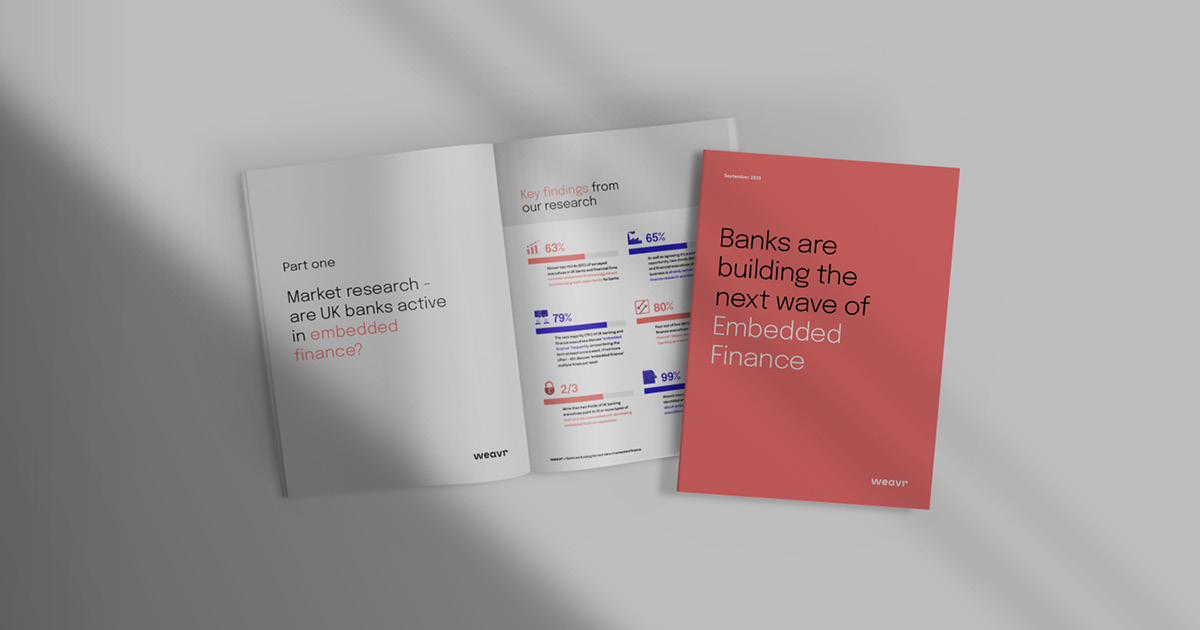Alex Mifsud, co-founder and CEO of Weavr, explains how embedded finance is expected to develop, what it means for financial inclusion and what Plug-and-Play Finance has to offer.
Can you tell us about Weavr? What’s the story behind it?
Weavr is a financial technology company that provides innovators with everything they need to easily integrate financial services into their products. Our software is not industry specific and can be utilised across all verticals, empowering small and large enterprises alike to issue financial accounts and payments cards, without the risk management and compliance responsibilities that are associated with financial services.
When my co-founder, Adrian Mizzi, and I came up with the idea for Weavr, we wanted to create a solution which made it as easy as possible for innovators to build and run these solutions for themselves. We’ve helped innovators in several sectors, including healthcare, B2B software, education, and employee benefits to improve their complete user experience using Weavr technology.
You said that Weavr is not here to ‘eat the lunch of the Banking-as-a-Service crowd’, but to increase the size of the cake – to make the embedded finance concept available to many more industries.’ Could you tell us a bit more about the next steps you have in mind?
The Weavr proposition is unlike many of the current Banking-as-a-Service (BaaS) offerings on the market today. Our technology isn’t aimed at enabling fintechs, rather it is an enabler to other software businesses. In using our technology, these software companies become more profitable, and at the same time, more valuable to their customers.
For example, let’s imagine an accountancy software that previously could only inform you of the invoices you need to pay. What if it could suddenly pay those invoices automatically for you? And, what if it also told you when the invoices you’d issued had received payment? The software has now removed the need for business owners to sit at home on a Sunday working out their cash flow, and what it might be in 12 months’ time as it has already been calculated automatically. At the same time, the accountancy software provider can now also make money from the extra financial services they are offering within their application. Overall, it’s a win-win situation, as the customer benefits from a smooth user experience, the software business benefits from higher monetisation, and the financial institutions in the background also profit from processing more transactions.
Ultimately, Weavr will displace some banking services, but it will add many more than it will displace. We’re not trying to replace banking as we know it, we’re simply introducing it in a bigger, more accessible form. So, to answer the question, the size of the cake is increased by including a financial service within the service you currently provide, and there are so many opportunities to do this in multiple markets and verticals.
As embedded finance evolves the financial world, how will banks shape the future?
Banks shape embedded finance, but embedded finance will begin to shape the banks too. This is because embedded finance is a radically new form of distribution for financial services while banks have become accustomed to having total control over how their services are delivered, whether that be online or through a mobile application.
With embedded finance, they have far less control over how the customer discovers and opts for, and consumes the financial service on offer, which makes this form of distribution extremely uncomfortable for banks. However, as uncomfortable as it may be at first, banks will have to evolve to match consumer demand and, if these consumers are choosing to transact through embedded financial services, it is likely that banks will have to facilitate ways of doing so.
Although sometimes a sticky subject for banks, many are very vocal in sharing their support for the technology which allows businesses to operate using embedded finance models. A substantial number of US banks are launching BaaS initiatives as they’ve discovered it’s a large revenue generator. Yet unfortunately, many of these institutions will discover that they don’t have the right kit to know exactly what the customer is actually doing to generate the activity they only see through their APIs. This could then lead to regulators auditing the bank and fining them if they have the inappropriate risk measures and compliance oversight in place.
Within the next 18-24 months, I predict that several of these BaaS projects will sadly be shut down. Embedded finance adoption will not be a linear path for banks. Some may support it but not action it. Some may be more adventurous and try it, and some will fail. But I hope those who fail will dust themselves off and update their technology to make it work.
Could you tell us what are the main differences between Plug-and-Play Finance and embedded finance? Do you think Plug-and-Play Finance represents the future of a digital financial world?
Embedded finance – or the integration of financial services in non-financial applications – is an outcome that can be achieved in several ways. One of them is Banking-as-a-Service (BaaS), and another, simpler approach is Plug-and-Play Finance. There’s a real binary difference between BaaS and Plug-and-Play Finance. If a software or tech business wanted to add financial services to broaden its capabilities using Banking-as-a-Service, that software company would need to do a whole lot of new things to meet the standards that the bank would expect such as onboarding customers, carrying out risk assessments, authenticating identification documents, and a plethora of customer service measures too. In doing all of these things, the business is no longer a software provider, but a fintech, which is a huge responsibility due to dealing with other people’s money.
Alternatively, the business could opt for a Plug-and-Play Finance software, like Weavr, which does all the banking leg work so to speak in a way that is adapted to each individual application and business model. In using Plug-and-Play Finance, businesses can focus on producing a great quality product or service, with financial services as an added bonus. What’s more, it avoids the complexity of building banking-grade solutions: a Plug-and-Play Finance solution is simply integrated just like any other piece of software. So, the answer is yes, Plug-and-Play Finance really does represent the future of a digital financial world.
What do you see as the biggest emerging trends in the embedded finance and Banking-as-a-Service arena?
At the moment, one of the key emerging trends is having the ability to equip innovators with the tools to improve their compliance performance. Although Weavr has been the first to offer and run these compliance tools, many BaaS providers have noted that prospective innovators just don’t have the appetite to build their own compliance stack. Some BaaS providers are offering compliance tools, but, unlike Weavr, still expect the innovators to operate these tools to meet their compliance responsibilities.
Another recent trend is the emergence of widgets to speed up user interface integration processes. These widgets are designed to improve user experience and speed up the solution at the same time, whilst giving banks more control over how the components are displayed and used by the end user.
Will the growth of embedded finance be one of the keys to driving financial inclusion and how?
Yes, I think embedded finance will be a real game changer for financial inclusion and there are two key reasons for this. The first is that, economically, banks may be less inclined to provide their financial services to people who have less wealth or a low salary because they are unlikely to see a return on the investment they have made in onboarding the customer. Secondly, many people have a lack of understanding of financial services due to its complexity. Many people don’t take out insurance policies or save for their retirement because they don’t understand or know how to do it properly.
Embedded finance addresses these root causes and is attributed to an overwhelming lack of financial inclusion. In adding financial services to an already widely adopted and profitable software application, banks no longer have to make the investment to acquire a potentially unprofitable customer, since the software business has already acquired and onboarded them themselves.
Moving on to the issue of complexity, customers are more likely to use a financial service if it is offered to them within the appropriate context that they understand, whether that’s planning their wedding or preparing for downsizing as they get older. This could really make a difference to many people’s lives in the long run.
Want to find out more about Weavr, or how Plug-and-Play Finance can help your platform?




